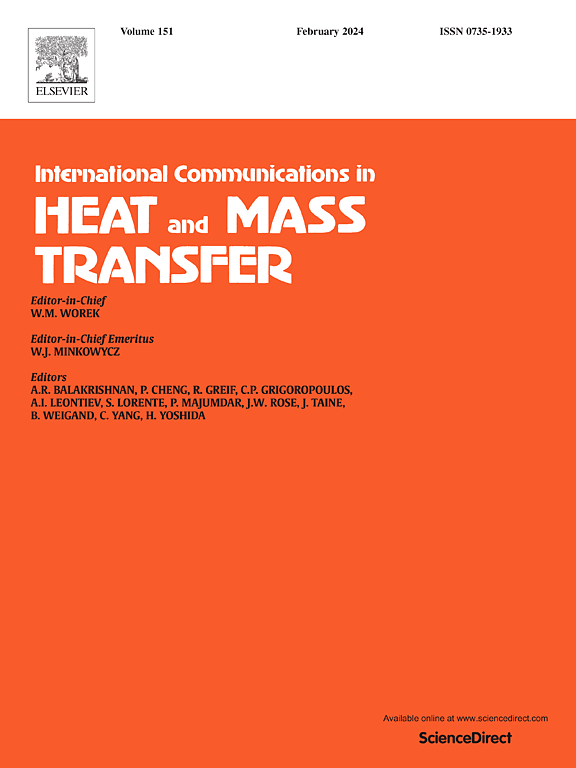Thermal and mechanical attributes and swelling percentage of hydrogels by changing in magnetic field frequency using computer simulation
IF 6.4
2区 工程技术
Q1 MECHANICS
International Communications in Heat and Mass Transfer
Pub Date : 2025-05-11
DOI:10.1016/j.icheatmasstransfer.2025.109070
引用次数: 0
Abstract
The thermodynamic, mechanical, and expansion properties of synthetic hydrogels derived from polyacrylamide (PAM) are investigated in this study to the impact of magnetic field frequency (MFF) as an external stimulus. The impact of various MFFs on essential parameters, such as swelling percentage (SP), ultimate strength (US), Young's modulus (YM), heat flux (HF), and thermal conductivity (TC), is assessed using Molecular Dynamics (MD) simulation with LAMMPS software, ranging from 0.01 to 0.05 1/fs. It is important to note that our results indicate that the structural volume decreased from 356,985 to 349,982 Å at 0.05 1/fs as the MFF increased. The alignment of polymer chains in the hydrogel was improved by increasing the MFF, resulting in a more compact structure. Through this compaction, the total structural volume diminished as the chains were drawn closer together, thereby reducing the spaces among them. US experienced a decrease from 0.0325 to 0.0331 MPa, while YM converged to 0.0008 MPa. The alignment and packaging of polymer chains improved, resulting in an increase in the US of hydrogels as the MFF increased. This enhanced alignment resulted in a material that can withstand a larger amount of stress before failing, as a result of the stronger intermolecular interactions. Additionally, the temperature coefficient (TC) increased to 0.56 W/m·K as the MFFs increased. An increase in molecular alignment and a decrease in free volume within the hydrogel can be attributed to the higher MFF. This enhanced alignment enabled the molecules to transfer heat more efficiently, resulting in improved TC and increased HF. These findings illustrate the substantial influence of MFF on hydrogel properties, offering valuable insights for the development of drug delivery systems and responsive materials.
利用计算机模拟研究了磁场频率变化对水凝胶热力学特性和溶胀率的影响
本文研究了磁场频率(MFF)作为外部刺激对聚丙烯酰胺(PAM)合成水凝胶的热力学、力学和膨胀性能的影响。不同MFFs对基本参数的影响,如膨胀率(SP)、极限强度(US)、杨氏模量(YM)、热流密度(HF)和导热系数(TC),使用LAMMPS软件进行分子动力学(MD)模拟,评估范围为0.01至0.05 1/fs。值得注意的是,我们的结果表明,随着MFF的增加,结构体积从356,985下降到349,982 Å,速度为0.05 1/fs。通过增加MFF可以改善水凝胶中聚合物链的排列,从而使水凝胶的结构更加紧凑。通过这种压实,总结构体积减少,因为链被拉近在一起,从而减少了它们之间的空间。美国从0.0325 MPa下降到0.0331 MPa,而YM收敛到0.0008 MPa。聚合物链的排列和包装得到改善,导致水凝胶的US随着MFF的增加而增加。由于更强的分子间相互作用,这种增强的排列导致材料在失败之前可以承受更大的应力。随着MFFs的增加,温度系数(TC)增加到0.56 W/m·K。分子排列的增加和水凝胶内自由体积的减少可归因于较高的MFF。这种增强的排列使分子更有效地传递热量,从而改善了TC和增加了HF。这些发现说明了MFF对水凝胶性质的重大影响,为药物输送系统和反应材料的开发提供了有价值的见解。
本文章由计算机程序翻译,如有差异,请以英文原文为准。
求助全文
约1分钟内获得全文
求助全文
来源期刊
CiteScore
11.00
自引率
10.00%
发文量
648
审稿时长
32 days
期刊介绍:
International Communications in Heat and Mass Transfer serves as a world forum for the rapid dissemination of new ideas, new measurement techniques, preliminary findings of ongoing investigations, discussions, and criticisms in the field of heat and mass transfer. Two types of manuscript will be considered for publication: communications (short reports of new work or discussions of work which has already been published) and summaries (abstracts of reports, theses or manuscripts which are too long for publication in full). Together with its companion publication, International Journal of Heat and Mass Transfer, with which it shares the same Board of Editors, this journal is read by research workers and engineers throughout the world.

 求助内容:
求助内容: 应助结果提醒方式:
应助结果提醒方式:


